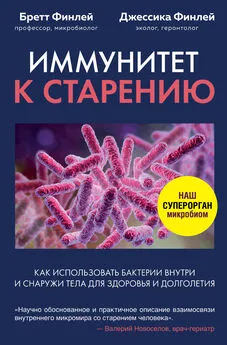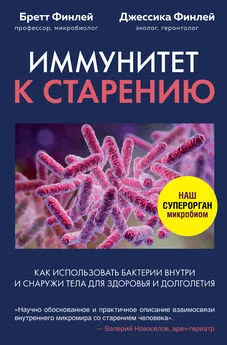Бретт Финлей - Иммунитет к старению. Как использовать бактерии внутри и снаружи тела для здоровья и долголетия
- Название:Иммунитет к старению. Как использовать бактерии внутри и снаружи тела для здоровья и долголетия
- Автор:
- Жанр:
- Издательство:ООО «Издательство «Эксмо»
- Год:2021
- Город:Москва
- ISBN:978-5-04-118241-0
- Рейтинг:
- Избранное:Добавить в избранное
-
Отзывы:
-
Ваша оценка:
Бретт Финлей - Иммунитет к старению. Как использовать бактерии внутри и снаружи тела для здоровья и долголетия краткое содержание
Иммунитет к старению. Как использовать бактерии внутри и снаружи тела для здоровья и долголетия - читать онлайн бесплатно ознакомительный отрывок
Интервал:
Закладка:
Cervantes-Barragan, L., Chai, J. N., Tianero, M. D., Di Luccia, B., Ahern, P. P., Merriman, J., . Colonna, M. (2017). Lactobacillus reuteri induces gut intraepithelial CD4(+)CD8alphaalpha(+) T cells. Science, 357(6353), 806–10. doi:10.1126/science.aah5825
Furusawa, Y., Obata, Y., Fukuda, S., Endo, T. A., Nakato, G., Takahashi, D., . Ohno, H. (2013). Commensal microbe-derived butyrate induces the differentiation of colonic regulatory T cells. Nature, 504(7480), 446–50. doi:10.1038/nature12721
Gill, N., & Finlay, B. B. (2011). The gut microbiota: challenging immunology. Nature Reviews. Immunology, 11(10), 636–37. doi:10.1038/nri3061
Honda, K., & Littman, D. R. (2016). The microbiota in adaptive immune homeostasis and disease. Nature, 535(7610), 75–84. doi:10.1038/nature18848
Hooper, L. V., Littman, D. R., & Macpherson, A. J. (2012). Interactions between the microbiota and the immune system. Science, 336(6086), 1268–73. doi:10.1126/ science.1223490
Ivanov, I. I., Frutos Rde, L., Manel, N., Yoshinaga, K., Rifkin, D. B., Sartor, R. B., . Littman, D. R. (2008). Specific microbiota direct the differentiation of IL-17– producing T-helper cells in the mucosa of the small intestine. Cell Host & Microbe, 4(4), 337–49. doi:10.1016/j.chom.2008.09.009
Mazmanian, S. K., Liu, C. H., Tzianabos, A. O., & Kasper, D. L. (2005). An immunomodulatory molecule of symbiotic bacteria directs maturation of the host immune system. Cell, 122(1), 107–18. doi:10.1016/j.cell.2005.05.007
Postler, T. S., & Ghosh, S. (2017). Understanding the Holobiont: How Microbial Metabolites Affect Human Health and Shape the Immune System. Cell Metabolism, 26(1), 110–30. doi:10.1016/j.cmet.2017.05.008
Salazar, N., Arboleya, S., Valdes, L., Stanton, C., Ross, P., Ruiz, L., . de Los ReyesGavilan, C. G. (2014). The human intestinal microbiome at extreme ages of life. Dietary intervention as a way to counteract alterations. Frontiers in Genetics, 5(406). doi:10.3389/fgene.2014.00406
Scher, J. U., Sczesnak, A., Longman, R. S., Segata, N., Ubeda, C., Bielski, C., . Littman, D. R. (2013). Expansion of intestinal Prevotella copri correlates with enhanced susceptibility to arthritis. eLife, 2, e01202. doi:10.7554/eLife.01202
Thevaranjan, N., Puchta, A., Schulz, C., Naidoo, A., Szamosi, J. C., Verschoor, C. P., . Bowdish, D. M. E. (2017). Age-Associated Microbial Dysbiosis Promotes Intestinal Permeability, Systemic Inflammation, and Macrophage Dysfunction. Cell Host & Microbe, 21(4), 455–66 e454. doi:10.1016/j.chom.2017.03.002
Zhong, D., Wu, C., Zeng, X., & Wang, Q. (2018). The role of gut microbiota in the pathogenesis of rheumatic diseases. Clinical Rheumatology, 37(1), 25–34. doi:10.1007/s10067-017–3821-4
Allen, J. M., Mailing, L. J., Niemiro, G. M., Moore, R., Cook, M. D., White, B. A., . Woods, J. A. (2018). Exercise Alters Gut Microbiota Composition and Function in Lean and Obese Humans. Medicine and Science in Sports and Exercise, 50(4), 747–57. doi:10.1249/MSS.0000000000001495
Bressa, C., Bailen-Andrino, M., Perez-Santiago, J., Gonzalez-Soltero, R., Perez, M., Montalvo-Lominchar, M. G., . Larrosa, M. (2017). Differences in gut microbiota profile between women with active lifestyle and sedentary women. PloS One, 12(2), e0171352. doi:10.1371/journal.pone.0171352
Claesson, M. J., Jeffery, I. B., Conde, S., Power, S. E., O’Connor, E. M., Cusack, S., . O’Toole, P. W. (2012). Gut microbiota composition correlates with diet and health in the elderly. Nature, 488(7410), 178–84. doi:10.1038/nature11319
Jackson, M. A., Jeffery, I. B., Beaumont, M., Bell, J. T., Clark, A. G., Ley, R. E., . Steves, C. J. (2016). Signatures of early frailty in the gut microbiota. Genome Medicine, 8(1), 8. doi:10.1186/s13073-016–0262-7
Kelaiditi, E., Jennings, A., Steves, C. J., Skinner, J., Cassidy, A., MacGregor, A. J., & Welch, A. A. (2016). Measurements of skeletal muscle mass and power are positively related to a Mediterranean dietary pattern in women. Osteoporosis International: a Journal Established as Result of Cooperation Between the European Foundation for Osteoporosis and the National Osteoporosis Foundation of the USA, 27(11), 3251–60. doi:10.1007/s00198-016–3665-9
O’Sullivan, O., Cronin, O., Clarke, S. F., Murphy, E. F., Molloy, M. G., Shanahan, F., & Cotter, P. D. (2015). Exercise and the microbiota. Gut Microbes, 6(2), 131–36. doi: 10.1080/19490976.2015.1011875
Rankin, A., O’Donavon, C., Madigan, S. M., O’Sullivan, O., & Cotter, P. D. (2017). ‘Microbes in sport’ – The potential role of the gut microbiota in athlete health and performance. British Journal of Sports Medicine, 51(9), 698–99. doi:10.1136/ bjsports-2016–097227
Steves, C. J., Bird, S., Williams, F. M., & Spector, T. D. (2016). The Microbiome and Musculoskeletal Conditions of Aging: A Review of Evidence for Impact and Potential Therapeutics. Journal of Bone and Mineral Research: the Official Journal of the American Society for Bone and Mineral Research, 31(2), 261–69. doi:10.1002/jbmr.2765
Villa, C. R., Ward, W. E., & Comelli, E. M. (2017). Gut microbiota-bone axis. Critical Reviews in Food Science and Nutrition, 57(8), 1664–72. doi:10.1080/10408398.2 015.1010034
Wang, J., Wang, Y., Gao, W., Wang, B., Zhao, H., Zeng, Y., . Hao, D. (2017). Diversity analysis of gut microbiota in osteoporosis and osteopenia patients. PeerJ, 5, e3450. doi:10.7717/peerj.3450
Weaver, C. M. (2015). Diet, gut microbiome, and bone health. Current Osteoporosis Reports, 13(2), 125–30. doi:10.1007/s11914-015–0257-0
Aliyu, S., Smaldone, A., & Larson, E. (2017). Prevalence of multidrug-resistant gramnegative bacteria among nursing home residents: A systematic review and metaanalysis. Am J Infect Control, 45(5), 512 18. doi:10.1016/j.ajic.2017.01.022
Andersen, B., Frisvad, J. C., Sondergaard, I., Rasmussen, I. S., & Larsen, L. S. (2011). Associations between fungal species and water-damaged building materials. Appl Environ Microbiol, 77(12), 4180–88. doi:10.1128/AEM.02513-10
Berg, G., Mahnert, A., & Moissl-Eichinger, C. (2014). Beneficial effects of plantassociated microbes on indoor microbiomes and human health? Front Microbiol, 5(15). doi:10.3389/fmicb.2014.00015
Bloomfield, S. F., Stanwell-Smith, R., Crevel, R. W. R., & Pickup, J. (2006). Too clean, or not too clean: the Hygiene Hypothesis and home hygiene. Clinical & Experimental Allergy, 36(4), 402–25. doi:10.1111/j.13652222.2006.02463.x
Cardinale, M., Kaiser, D., Lueders, T., Schnell, S., & Egert, M. (2017). Microbiome analysis and confocal microscopy of used kitchen sponges reveal massive colonization by Acinetobacter, Moraxella and Chryseobacterium species.Sci Rep, 7(1), 5791. doi:10.1038/s41598-017–06055-9
David, L. A., Materna, A. C., Friedman, J., Campos-Baptista, M. I., Blackburn, M. C., Perrotta, A., . Alm, E. J. (2014). Host lifestyle affects human microbiota on daily timescales. Genome Biology, 15, R89. doi:10.1186/gb-2014–15-7-r89
Hoisington, A. J., Brenner, L. A., Kinney, K. A., Postolache, T. T., & Lowry, C. A. (2015). The microbiome of the built environment and mental health. Microbiome, 3(60). doi:10.1186/s40168-015–0127-0
Koljalg, S., Mandar, R., Sober, T., Roop, T., & Mandar, R. (2017). High level bacterial contamination of secondary school students’ mobile phones. Germs, 7(2), 73–77. doi:10.18683/germs.2017.1111
Lax, S., Smith, D. P., Hampton-Marcell, J., Owens, S. M., Handley, K. M., Scott, N. M., . Gilbert, J. A. (2014). Longitudinal analysis of microbial interaction between humans and the indoor environment. Science, 345(6200), 1048–52. doi:10.1126/science.1254529
Meadow, J. F., Altrichter, A. E., & Green, J. L. (2014). Mobile phones carry the personal microbiome of their owners. PeerJ, 2, e447. doi:10.7717/peerj.447
Peccia, J., & Kwan, S. E. (2016). Buildings, Beneficial Microbes, and Health. Trends Microbiol, 24(8), 595–97. doi:10.1016/j.tim.2016.04.007
Riddle, M. S., & Connor, B. A. (2016). The Traveling Microbiome. Curr Infect Dis Rep, 18(9), 29. doi:10.1007/s11908-016–0536-7
Rothschild, D., Weissbrod, O., Barkan, E., Kurilshikov, A., Korem, T., Zeevi, D., . Segal, E. (2018). Environment dominates over host genetics in shaping human gut microbiota. Nature, 555(7695), 210–15. doi:10.1038/nature25973
Biagi, E., Candela, M., Turroni, S., Garagnani, P., Franceschi, C., & Brigidi, P. (2013). Ageing and gut microbes: perspectives for health maintenance and longevity. Pharmacological Research, 69(1), 11–20. doi:10.1016/j.phrs.2012.10.005
Blaser, M. J. (2014). Missing Microbes: How the Overuse of Antibiotics is Fueling Our Modern Plagues. New York, NY: Henry Holt and Company.
Brandt, L. J. (2017). Fecal Microbiota Therapy With a Focus on Clostridium difficile Infection. Psychosomatic Medicine, 79(8), 868–73. doi:10.1097/ PSY.0000000000000511
Brüssow, H. (2013). Microbiota and healthy ageing: observational and nutritional intervention studies. Microbial Biotechnology, 6(4), 326–34. doi:10.1111/1751–7915.12048
Buettner, D. (2008). The Blue Zones: Lessons for Living Longer From the People Who’ve Lived the Longest. Washington, DC: National Geographic Society.
Cockburn, D. W., & Koropatkin, N. M. (2016). Polysaccharide Degradation by the Intestinal Microbiota and Its Influence on Human Health and Disease. Journal of Molecular Biology, 428(16), 3230–52. doi:10.1016/j.jmb.2016.06.021
Fond, G., Boukouaci, W., Chevalier, G., Regnault, A., Eberl, G., Hamdani, N., . Leboyer, M. (2015). The “psychomicrobiotic”: Targeting microbiota in major psychiatric disorders: A systematic review. Pathologie-Biologie, 63(1), 35–42. doi:10.1016/j.patbio.2014.10.003
Gibson, G. R., Hutkins, R., Sanders, M. E., Prescott, S. L., Reimer, R. A., Salminen, S. J., . Reid, G. (2017). Expert consensus document: The International Scientific Association for Probiotics and Prebiotics (ISAPP) consensus statement on the definition and scope of prebiotics. Nature Reviews. Gastroenterology & Hepatology, 14(8), 491–502. doi:10.1038/nrgastro.2017.75
Han, B., Sivaramakrishnan, P., Lin, C. J., Neve, I. A. A., He, J., Tay, L. W. R., . Wang, M. C. (2017). Microbial Genetic Composition Tunes Host Longevity. Cell, 169(7), 1249–62 e1213. doi:10.1016/j.cell.2017.05.036
Hod, K., & Ringel, Y. (2016). Probiotics in functional bowel disorders. Best Practice & Research. Clinical Gastroenterology, 30(1), 89–97. doi:10.1016/j.bpg.2016.01.003
Horvath, A., Leber, B., Schmerboeck, B., Tawdrous, M., Zettel, G., Hartl, A., . Stadlbauer, V. (2016). Randomised clinical trial: the effects of a multispecies probiotic vs. placebo on innate immune function, bacterial translocation and gut permeability in patients with cirrhosis. Alimentary Pharmacology & Therapeutics, 44(9), 926–35. doi:10.1111/apt.13788
Hungin, A. P. S., Mitchell, C. R., Whorwell, P., Mulligan, C., Cole, O., Agreus, L., . de Wit, N. (2018). Systematic review: probiotics in the management of lower gastrointestinal symptoms – an updated evidence-based international consensus. Alimentary Pharmacology & Therapeutics, 47(8), 1054–70. doi:10.1111/apt.14539
Konig, J., Siebenhaar, A., Hogenauer, C., Arkkila, P., Nieuwdorp, M., Noren, T., . Brummer, R. J. (2017). Consensus report: faecal microbiota transfer – clinical applications and procedures. Alimentary Pharmacology & Therapeutics, 45(2), 222–39. doi:10.1111/apt.13868
Читать дальшеИнтервал:
Закладка:



![Валерий Полунин - Методы Востока для здоровья. Как оставаться молодым и активным в 50, 70, 90 лет [=Живите долго! Рецепты Аюрведы для здоровья и долголетия]](/books/1055946/valerij-polunin-metody-vostoka-dlya-zdorovya-kak-o.webp)
![Тим Беркхед - Самая совершенная вещь на свете [Внутри и снаружи птичьего яйца]](/books/1069359/tim-berkhed-samaya-sovershennaya-vech-na-svete-vnutr.webp)



